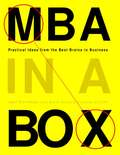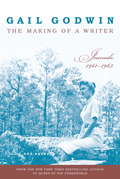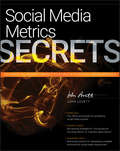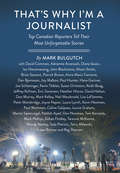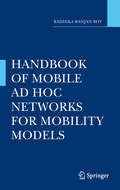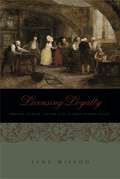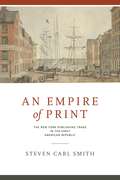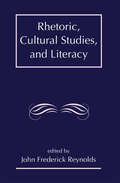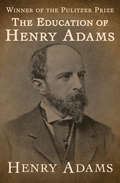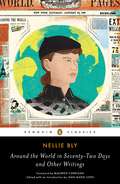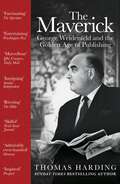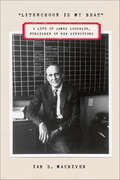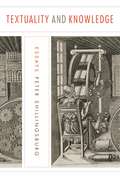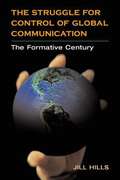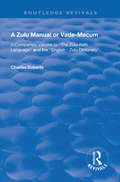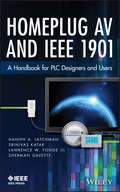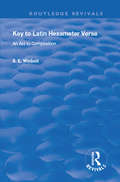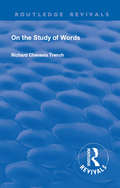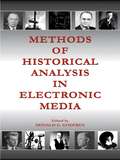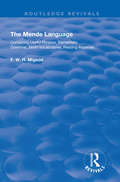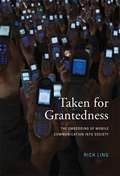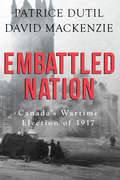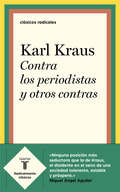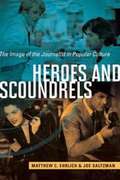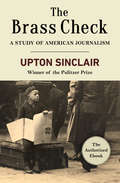- Table View
- List View
MBA in a Box: Practical Ideas from the Best Brains in Business
by Joel Kurtzman Glenn Rifkind Victoria GriffithThe best minds in business—at your serviceMBA in a Box brings together some of the best brains in business who show how the core curriculum of an MBA program works in the real world. People like Michael Porter, Rosabeth Moss Kanter, Adrian J. Slywotzky, Warren Bennis, and Bill George give you a box full of ideas and tools that can boost your career and help you add value to your organization. For example: • Why finance is not just about manipulating numbers but of immense importance in sustaining growth, building widespread wealth, and creating jobs. • The profit zone and how to tell if a business is in one. • The skill of turning an idea or invention into a product that solves a problem for a market. • Merging the need of business to produce and grow with the environment so they are both sustained. • The latest thinking in marketing about branding, pricing, reversing a product’s life cycle, and turning what has become a commodity into a specialty.• And much more.
The Making of a Writer
by Gail GodwinGail Godwin was twenty-four years old when she wrote: “I want to be everybody who is great; I want to create everything that has ever been created. ” It is a declaration that only a wildly ambitious young writer would make in the privacy of her journal. Now, inThe Making of a Writer, Godwin has distilled her early journals, which run from 1961 to 1963, to their brilliant and charming essence. She conveys the feverish period following the breakup of her first marriage; the fateful decision to move to Europe and the shock of her first encounters with Danish customs (and Danish men); the pleasures of soaking in the human drama on long rambles through the London streets and the torment of lonely Sundays spent wrestling these impressions into prose; and the determination to create despite rejection and a growing stack of debts. “I do not feel like a failure,” Godwin insists. “I will keep writing, harder than ever. ” Brimming with urgency and wit, Godwin’s inspiring tome opens a shining window into the life and craft of a great writer just coming into her own. “A generous gift from a much-loved author to her readers. ” –Chicago Sun-Times “Full of lively, entertaining observations on the literary life . . . [captures] the spirit of a young writer’s adventure into foreign lands and foreign realms of thought and creative endeavor. ” –The Atlanta Journal-Constitution “As cities and continents and men change, the entries are borne along by . . . the young Godwin’s fierce conviction that she is meant to write fiction and her desire to distract herself from this mission with any man who catches her eye. ” –The New York Times Book Review “[Godwin] describes a high-wire act of love and work. . . . She espouses fierce, uncompromising ideas about fiction. ” –Los Angeles Times “[Gail Godwin’s journals] are a gold mine. ” –The Boston Globe
Social Media Metrics Secrets
by John LovettInvaluable advice on analyzing and measuring the effects of social mediaDo you wish you could sit down with an expert to figure out whether or not your social media initiatives are working? With Social Media Metrics Secrets, you can! Expert John Lovett taps into his years of training and experience to reveal tips, tricks, and advice on how to analyze and measure the effects of social media and gauge the success of your initiatives. He uses mini case studies to demonstrate how to manage social operations with process and technology by applying key performance indicators, and assessing the business value of social media.Highlights how social media can impact all aspects of your business and transform the way you quantify successful interactions with customers Shares innovative techniques for managing the massive volume of social analytics data by putting data to work in ways that contribute to your organizational goals Details techniques for adopting a Social Analytics Framework for understanding evolving consumer behavior necessary to compete in a socially networked future Written in a conversational tone, Social Media Metrics Secrets goes behind the scenes to present you with unbeatable advice and unparalleled insight into social media metrics.
That's Why I'm a Journalist
by Mark BulgutchNews stories are like collective memories, encapsulating the most iconic moments in recent history around the world. But to those who work in journalism, up-close involvement with these stories can also be life-changing. In That's Why I'm a Journalist, veteran broadcaster Mark Bulgutch interviews 44 prominent Canadian journalists, who each share their behind-the-scenes accounts of some of the most memorable stories of their careers and describe the moment that made them say to themselves, "That's why I'm a journalist."Although many of the contributors' stories are related to their roles in the most high-profile events of the 20th and 21st centuries, from the fall of the Berlin Wall to 9/11, here too are reflections on quieter and more intimate moments that had a deep personal impact. Peter Mansbridge talks about a trip to Vimy Ridge on the hundredth anniversary of World War I, Adrienne Arsenault recalls bringing together old friends separated by the Israeli-Palestinian conflict, Terence McKenna recounts what it's like to worry about being kidnapped as part of the job and Wendy Mesley reflects on the satisfaction of asking tough questions-and uncovering the truth.Together, these enthralling and varied accounts provide an intimate understanding of the people we see on camera and hear on the radio. As Bulgutch argues, modern journalism is undergoing existential threats. News has never been more accessible yet, paradoxically, important news has become harder to find, often buried by pseudo-news of celebrity, lifestyle tips and the latest viral video of a water-skiing squirrel. The stories in this book serve as reminders of the importance of real journalists and real journalism.
Handbook of Mobile Ad Hoc Networks for Mobility Models
by Radhika Ranjan RoyThe Mobile Ad Hoc Network (MANET) has emerged as the next frontier for wireless communications networking in both the military and commercial arena. Handbook of Mobile Ad Hoc Networks for Mobility Models introduces 40 different major mobility models along with numerous associate mobility models to be used in a variety of MANET networking environments in the ground, air, space, and/or under water mobile vehicles and/or handheld devices. These vehicles include cars, armors, ships, under-sea vehicles, manned and unmanned airborne vehicles, spacecrafts and more. This handbook also describes how each mobility pattern affects the MANET performance from physical to application layer; such as throughput capacity, delay, jitter, packet loss and packet delivery ratio, longevity of route, route overhead, reliability, and survivability. Case studies, examples, and exercises are provided throughout the book. Handbook of Mobile Ad Hoc Networks for Mobility Models is for advanced-level students and researchers concentrating on electrical engineering and computer science within wireless technology. Industry professionals working in the areas of mobile ad hoc networks, communications engineering, military establishments engaged in communications engineering, equipment manufacturers who are designing radios, mobile wireless routers, wireless local area networks, and mobile ad hoc network equipment will find this book useful as well.
Licensing Loyalty: Printers, Patrons, and the State in Early Modern France (Penn State Series in the History of the Book)
by Jane McLeodIn Licensing Loyalty, historian Jane McLeod explores the evolution of the idea that the royal government of eighteenth-century France had much to fear from the rise of print culture. She argues that early modern French printers helped foster this view as they struggled to negotiate a place in the expanding bureaucratic apparatus of the French state. Printers in the provinces and in Paris relentlessly lobbied the government, hoping to convince authorities that printing done by their commercial rivals posed a serious threat to both monarchy and morality. By examining the French state’s policy of licensing printers and the mutually influential relationships between officials and printers, McLeod sheds light on our understanding of the limits of French absolutism and the uses of print culture in the political life of provincial France.
An Empire of Print: The New York Publishing Trade in the Early American Republic (Penn State Series in the History of the Book)
by Steven Carl SmithHome to the so-called big five publishers as well as hundreds of smaller presses, renowned literary agents, a vigorous arts scene, and an uncountable number of aspiring and established writers alike, New York City is widely perceived as the publishing capital of the United States and the world. This book traces the origins and early evolution of the city’s rise to literary preeminence.Through five case studies, Steven Carl Smith examines publishing in New York from the post–Revolutionary War period through the Jacksonian era. He discusses the gradual development of local, regional, and national distribution networks, assesses the economic relationships and shared social and cultural practices that connected printers, booksellers, and their customers, and explores the uncharacteristically modern approaches taken by the city’s preindustrial printers and distributors. If the cultural matrix of printed texts served as the primary legitimating vehicle for political debate and literary expression, Smith argues, then deeper understanding of the economic interests and political affiliations of the people who produced these texts gives necessary insight into the emergence of a major American industry. Those involved in New York’s book trade imagined for themselves, like their counterparts in other major seaport cities, a robust business that could satisfy the new nation’s desire for print, and many fulfilled their ambition by cultivating networks that crossed regional boundaries, delivering books to the masses.A fresh interpretation of the market economy in early America, An Empire of Print reveals how New York started on the road to becoming the publishing powerhouse it is today.
Rhetoric, Cultural Studies, and Literacy: Selected Papers From the 1994 Conference of the Rhetoric Society of America
by John Frederick ReynoldsThis volume presents a representative cross-section of the more than 200 papers presented at the 1994 conference of the Rhetoric Society of America. The contributors reflect multi- and inter-disciplinary perspectives -- English, speech communication, philosophy, rhetoric, composition studies, comparative literature, and film and media studies. Exploring the historical relationships and changing relationships between rhetoric, cultural studies, and literacy in the United States, this text seeks answers to such questions as what constitutes "literacy" in a post-modern, high-tech, multi-cultural society?
The Education of Henry Adams: An Autobiography (The\best Sellers Of 1919 Ser.)
by Henry AdamsThe Modern Library's number-one nonfiction book of the twentieth century and winner of the Pulitzer Prize: The acclaimed memoir of a brilliant man reckoning with an era of profound change The great-grandson of President John Adams and the grandson of President John Quincy Adams, Henry Adams possessed one of the most remarkable minds of his generation. Yet he believed himself fundamentally unsuited to the era in which he lived--the tumultuous period between the Civil War and World War I. One of the finest autobiographies ever written, The Education of Henry Adams is a remarkable and uniquely unclassifiable work. Written in third person and originally circulated in a private edition to friends and family only, it recounts Adams's lifelong search for self-knowledge and moral enlightenment and bears witness to some of the most significant developments in American history. This ebook has been professionally proofread to ensure accuracy and readability on all devices.
Around the World in Seventy-Two Days and Other Writings
by Nellie BlyA collection of the articles and writings of famed American journalist Nellie Bly. .
The Maverick: George Weidenfeld and the Golden Age of Publishing
by Thomas HardingBorn into a Jewish family in Vienna in 1919, George Weidenfeld fled to England in 1938 to escape the Nazi regime. There he began a career in publishing that would make him one of the most influential figures in the industry. Over the course of his long and illustrious career he championed some of the most important voices of the twentieth century, from Vladimir Nabokov, Mary McCarthy and Saul Bellow to Harold Wilson, Isaiah Berlin and Henry Kissinger.But what do we know about the man himself? Was he, as described by some, the 'greatest salesperson', 'the world's best networker', 'the publisher's publisher' and 'a great intellectual'? Was his lifelong effort to be the world's most famous host a cover for his desperate loneliness? Who, in fact, was the real George Weidenfeld and how did he rise so successfully within the ranks of London and New York society? Providing a full, unvarnished and at times difficult history of this complex man, this first biography of a titan of culture is also a story of resilience, determination and the power of ideas to shape history.
"Literchoor Is My Beat": A Life of James Laughlin, Publisher of New Directions
by Ian S. MacNivenA biography—thoughtful and playful—of the man who founded New Directions and transformed American publishingJames Laughlin—poet, publisher, world-class skier—was the man behind some of the most daring, revolutionary works in verse and prose of the twentieth century. As the founder of New Directions, he published Ezra Pound's The Cantos and William Carlos Williams's Paterson; he brought Hermann Hesse and Jorge Luis Borges to an American audience. Throughout his life, this tall, charismatic intellectual, athlete, and entrepreneur preferred to stay hidden. But no longer—in "Literchoor Is My Beat": A Life of James Laughlin, Publisher of New Directions, Ian S. MacNiven has given us a sensitive and revealing portrait of this visionary and the understory of the last century of American letters. Laughlin—or J, as MacNiven calls him—emerges as an impressive and complex figure: energetic, idealistic, and hardworking, but also plagued by doubts—not about his ability to identify and nurture talent but about his own worth as a writer. Haunted by his father's struggles with bipolar disorder, J threw himself into a flurry of activity, pulling together the first New Directions anthology before he'd graduated from Harvard and purchasing and managing a ski resort in Utah. MacNiven's portrait is comprehensive and vital, spiced with Ezra Pound's eccentric letters, J's romantic foibles, and anecdotes from a seat-of-your-pants era of publishing now gone by. A story about the struggle to publish only the best, it is itself an example of literary biography at its finest.
Textuality and Knowledge: Essays (Penn State Series in the History of the Book)
by Peter ShillingsburgIn literary investigation all evidence is textual, dependent on preservation in material copies. Copies, however, are vulnerable to inadvertent and purposeful change. In this volume, Peter Shillingsburg explores the implications of this central concept of textual scholarship.Through thirteen essays, Shillingsburg argues that literary study depends on documents, the preservation of works, and textual replication, and he traces how this proposition affects understanding. He explains the consequences of textual knowledge (and ignorance) in teaching, reading, and research—and in the generous impulses behind the digitization of cultural documents. He also examines the ways in which facile assumptions about a text can lead one astray, discusses how differing international and cultural understandings of the importance of documents and their preservation shape both knowledge about and replication of works, and assesses the dissemination of information in the context of ethics and social justice. In bringing these wide-ranging pieces together, Shillingsburg reveals how and why meaning changes with each successive rendering of a work, the value in viewing each subsequent copy of a text as an original entity, and the relationship between textuality and knowledge.Featuring case studies throughout, this erudite collection distills decades of Shillingsburg’s thought on literary history and criticism and appraises the place of textual studies and scholarly editing today.
The Struggle for Control of Global Communication: THE FORMATIVE CENTURY
by Jill HillsTracing the development of communication markets and the regulation of international communications from the 1840s through World War I, Jill Hills examines the political, technological, and economic forces at work during the formative century of global communication. The Struggle for Control of Global Communication analyzes power relations within the arena of global communications from the inception of the telegraph through the successive technologies of submarine telegraph cables, ship-to-shore wireless, broadcast radio, shortwave wireless, the telephone, and movies with sound. Global communication began to overtake transportation as an economic, political, and social force after the inception of the telegraph, which shifted communications from national to international. From that point on, says Hills, information was a commodity and ownership of the communications infrastructure became valuable as the means of distributing information. The struggle for control of that infrastructure occurred in part because the growing economic power of the United States was hindered by British control of communications. Hills outlines the technological advancements and regulations that allowed the United States to challenge British hegemony and enter the global communications market. She demonstrates that control of global communication was part of a complex web of relations between and within the government and corporations of Britain and the United States. Detailing the interplay between U.S. federal regulation and economic power, Hills shows how communication technologies have been shaped by these forces and fosters an understanding of contemporary systems of power in global communications.
A Zulu Manual or Vade-Mecum: A Companion Volume to ''The Zulu-Kafir Language'', And The '' English - Zulu Dictonary''. (Routledge Revivals)
by Charles RobertsPublished in 1900, this book provides a companion volume to the Zulu Kafir Language and the English Zulu Dictionary. Including a dictionary and examples of language structure and grammar, this book makes Zulu accessible to all levels of learner.
Homeplug AV and IEEE 1901
by Larry Yonge Sherman Gavette Srinivas Katar Haniph A. LatchmanThe only authorized book explaining the HomePlug networking standardsHomePlug is a growing technology for creating high-speed Power Line Communication (PLC) networks by transmitting data over in-home or in-office power lines. Users only need to plug adapters into wall outlets to create an instant network of computers, printers, routers, home entertainment devices, and appliance control systems.HomePlug AV and IEEE 1901: A Handbook for PLC Designers and Users provides for the first time an opportunity for non-members of the HomePlug Alliance to gain in-depth insight into the design and operation of the HomePlug standards. Offering a clear and simple description of the standards, this groundbreaking resource presents HomePlug AV and the associated IEEE 1901 standards in terms more readily understood by a much wider audience, including nontechnical managers, engineers, students, and HomePlug designers.The book details the many benefits of HomePlug AV, including:An affordable, secure alternative or complement to WiFi--especially in buildings where WiFi reception is poor or running new network wires is impracticalHigher potential data transmission rates up to 200 MbpsSupport for multimedia applications such as HDTV and VoIPThe book also provides an overview of the HomePlug Green PHY standard that is targeted for use in smart energy applications, and the HomePlug AV 2.0 standard that operates at up to 1.5 Gbps.An essential tool for designers of HomePlug devices, network administrators, and individual users of HomePlug networks who need to understand the features and capabilities of HomePlug, HomePlug AV and IEEE 1901: A Handbook for PLC Designers and Users will also prove useful for researchers in academia and the power line communications industry.
Key to Latin Hexameter Verse: An Aid to Composition (Routledge Revivals)
by S. E. WinboltOriginally published in 1903.
Revival: On the Study of Words (Routledge Revivals)
by Richard Chenevix TrenchFirst published in 1904, this book contains the conclusions of a series of lectures exploring the moral and historical value of single words. The author argues that, just as wisdom and knowledge are discoverable in books, so too are these treasures to be found in individual words themselves.
Methods of Historical Analysis in Electronic Media (Routledge Communication Series)
by Donald G. GodfreyMethods of Historical Analysis in Electronic Media provides a foundation for historical research in electronic media by addressing the literature and the methods--traditional and the eclectic methods of scholarship as applied to electronic media. It is about history--broadcast electronic media history and history that has been broadcast, and also about the historiography, research written, and the research yet to be written.Divided into five parts, this book:*addresses the challenges in the application of the historical methods to broadcast history;*reviews the various methods appropriate for electronic-media research based on the nature of the object under study;*suggests new approaches to popular historical topics;*takes a broad topical look at history in broadcasting; and*provides a broad overview of what has been accomplished, a historian's challenges, and future research.Intended for students and researchers in broadcast history, Methods of Historical Analysis in Electronic Media provides an understanding of the qualitative methodological tools necessary for the study of electronic media history, and illustrates how to find primary sources for electronic media research.
The Mende Language: Containing Useful Phrases, Elementary Grammar, Short Vocabularies, Reading Materials (Routledge Revivals)
by F.W.H. MigeodFirst published in 1908, this volume emerged in the midst of the British Protectorate of Sierra Leone. The author, F.W.H. Migeod, studied the Mende nation in eastern Sierra Leone and followed the example of the grammar (1882) and vocabulary (1884) published by Dr. Schoen in using the southern form of the Mende language. Beginning with an introduction to the recent history, culture and characteristics of the Mende nation and Sierra Leone, this volume covers useful phrases, grammar, vocabulary and example reading materials including stories and songs collected from native speakers.
Taken for Grantedness
by Rich LingWhy do we feel insulted or exasperated when our friends and family don't answer their mobile phones? If the Internet has allowed us to broaden our social world into a virtual friend-net, the mobile phone is an instrument of a more intimate social sphere. The mobile phone provides a taken-for-granted link to the people to whom we are closest; when we are without it, social and domestic disarray may result. In just a few years, the mobile phone has become central to the functioning of society. In this book, Rich Ling explores the process by which the mobile phone has become embedded in society, comparing it to earlier technologies that changed the character of our social interaction and, along the way, became taken for granted. Ling, drawing on research, interviews, and quantitative material, shows how the mobile phone (and the clock and the automobile before it) can be regarded as a social mediation technology, with a critical mass of users, a supporting ideology, changes in the social ecology, and a web of mutual expectations regarding use. By examining the similarities and synergies among these three technologies, Ling sheds a more general light on how technical systems become embedded in society and how they support social interaction within the closest sphere of friends and family
Embattled Nation: Canada's Wartime Election of 1917
by David Mackenzie Patrice DutilEmbattled Nation explores Canada’s tense wartime election of 1917. Amidst the drama of the First World War, Canada’s most divisive election ever raised pivotal questions about Canada’s place in the war and the world. This book examines the issues, people, and events behind one of the most important elections in Canada’s history.
Contra los periodistas y otros contras
by Karl Kraus«Ninguna posición más seductora que la de Kraus, el disidente en el seno de una sociedad tolerante, estable y próspera.»Miguel Ángel Aguilar «Quien sea capaz de escribir aforismos no debiera desparramarse en artículos», afirma Karl Kraus, quien con gran inteligencia, ironía y capacidad de síntesis se despachó en estos textos contra la moral imperante, los políticos, la religión, la decadencia de la cultura y del lenguaje, los estetas, y por supuesto los periodistas y los medios de comunicación. Deslumbrantes, oportunas, a veces irritantes y siempre impertinentes, sus advertencias resuenan furiosamente en nuestro presente. Karl Kraus (Ji?ín, actual República Checa, 1874 - Viena, 1936) fue un eminente escritor y periodista conocido como ensayista, aforista, dramaturgo y poeta. Gran polemista, tuvo por principal arma Die Fackel, revista de gran audiencia que editó y escribió casi en solitario desde 1899 y durante treinta y siete años. Figuras como Schönberg, Musil, Canetti, Wittgenstein o Adorno esperaban impacientes la aparición del siguiente número. Reseñas:«Ninguna posición más seductora que la de Kraus, el disidente en el seno de una sociedad tolerante, estable y próspera.»Miguel Ángel Aguilar «Los periodistas representan la relajación del estilo y la falta de moralidad de la profesión. Kraus es el redentor; mientras Kraus exista y fulmine, todo está controlado.»Robert Musil «El mayor satírico en lengua alemana del siglo XX.»Isidoro Reguera
Heroes and Scoundrels: The Image of the Journalist in Popular Culture
by Matthew C. Ehrlich Joe SaltzmanWhether it's the rule-defying lifer, the sharp-witted female newshound, or the irascible editor in chief, journalists in popular culture have shaped our views of the press and its role in a free society since mass culture arose over a century ago. Drawing on portrayals of journalists in television, film, radio, novels, comics, plays, and other media, Matthew C. Ehrlich and Joe Saltzman survey how popular media has depicted the profession across time. Their creative use of media artifacts provides thought-provoking forays into such fundamental issues as how pop culture mythologizes and demythologizes key events in journalism history and how it confronts issues of race, gender, and sexual orientation on the job. From Network to The Wire, from Lois Lane to Mikael Blomkvist, Heroes and Scoundrels reveals how portrayals of journalism's relationship to history, professionalism, power, image, and war influence our thinking and the very practice of democracy.
The Brass Check: A Study of American Journalism (American Journalists Ser.)
by Upton SinclairA muckraking exposé of corruption in American journalism from the Pulitzer Prize-winning author of The Jungle Upton Sinclair dedicated his life to documenting the destructive force of unbridled capitalism. In this influential study, he takes on the effect of money and power on mass media, arguing that the newspapers, magazines, and wire services of the Progressive era formed "a class institution serving the rich and spurning the poor." In the early twentieth century, a "brass check" was a token purchased by brothel patrons. By drawing a comparison between journalists and prostitutes, Sinclair highlights the total control publishers such as William Randolph Hearst exerted over their empires. Reporters and editors were paid to service the financial and political interests of their bosses, even if that meant misrepresenting the facts or outright lying. Sinclair documents specific cases, including the Ludlow Massacre of 1914 and the Red Scare whipped up by Hearst's New York Journal and other newspapers, in which major news outlets ignored the truth in favor of tabloid sensationalism. Sinclair considered The Brass Check to be his most important and most dangerous book. Nearly a century later, his impassioned call for reform is timelier than ever. This ebook has been authorized by the estate of Upton Sinclair.
